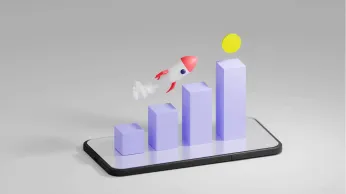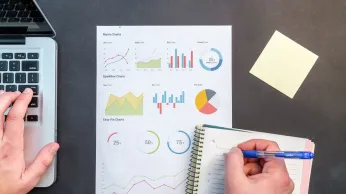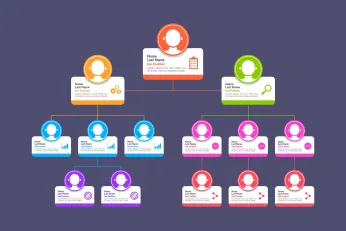Nesta página
How the right sales forecasting method can help a business stay ahead of both the curve, and the curveball.
Sales forecasting plays a vital role in helping businesses plan ahead, allocate resources efficiently, and achieve sustainable growth. By examining historical data, market trends, and customer behavior patterns, companies can make informed predictions about future sales. This enables better goal setting, inventory management, and financial planning. In this blog, we’ll break down key forecasting techniques—both quantitative and qualitative—that businesses can adopt to stay ahead.
From time series analysis to expert-driven insights, each method offers valuable perspectives on potential performance. Accurate forecasts help reduce uncertainties and support strategic decisions across departments.
Whether you're running a small startup or a well-established organization, mastering these methods will empower you to anticipate market changes, make proactive choices, and unlock new growth opportunities.
Join us as we explore the most reliable techniques for predicting sales outcomes and positioning your business for long-term success.
O que é a previsão de vendas?
Sales forecasting is a mechanism for evaluating future sales. The ability to predict potential demand and mobilize resources at the right time to convert it into revenue is the most valuable trait of a business.
A sales forecast combines data with intuition to create an expression of expected performance at a moment in time that’s set in the future. It helps in better goal setting, budgeting and risk management.
Like most forecasts, a sales forecast is a manifestation of the fundamental human need to stay in control over its destiny. Uncertainty, after all, can be unnerving - especially when stakes are high. Sales forecasting methods serve to confirm gut feelings and assuage worry-lines in leaders as they are point their ships in beneficial directions.
Sales forecasting frameworks generate in-depth ‘visibility reports’, letting revenue, sales and product teams see what their performance vitals might look like going forward.
Sales forecasting models are typically designed to address questions like:
- What is the size of the opportunity or revenue that lies ahead.
- When is it most likely to materialize.
- Why do we expect the transaction to happen at that particular point of time.
- Where - i.e., at which point of the customer journey - will the buying decision be made.
- Who will be responsible for driving the sale, and
- How is the conversion expected to pan out. That is, the operational nitty-gritties.
More than crystal ball gazing: A DNA for organization wide success
Sales forecasting – sometimes interchangeably referred to as demand forecasting - isn’t a mind-trick or prophecy challenge about who can predict the future with pinpoint accuracy. It is, at heart, an approach and a mindset. It reflects an organizational commitment to maximize outcomes via the path of minimum wastage by reducing random, unvalidated efforts.
While the overarching purpose of sales forecasting methods is to simplify revenue prediction, the best ones end up achieving much more: They unlock potential, share a holistic roadmap for the business, and make sure to leave breathing space for error. Great forecasting models will masterfully blend hindsight and foresight to tilt the odds of success in the business’ favor.
In the hands of experts, they transform into all powerful instruments - fine tuning resource allocation, hedging against financial disasters and laying down the blueprint for a sustainable journey.
A sales culture that deftly integrates forecasting into its daily fabric levels up the team’s appetite for success, relentlessly nudging sales and channels to go after big opportunities. It’s not all mathematics and calculations, though. Great leaders will often throw a dose of personal prescience into the mix, using their ‘sixth sense’ to recce hypothetical horizons cookie-cutter software cannot, thereby stealing a march over rivals.
Why is sales forecasting important in business?
Sales forecasting models are for decision makers what maps and compasses are to explorers. They help minimize guesswork, enabling navigation through chaos and uncertainty with some degree of order and confidence. Without them, running a business in a complex new reality can be akin to throwing darts in the dark.
Sales forecasting takes a business from reactive to proactive mode. Instead of waiting for disruption to throw the system off-balance, forecasting empowers the business to anticipate it and, in best case scenarios, turn it into an advantage.
Sales forecasting can elevate nearly every nut and bolt in of a profit system, right from operational roadmaps to budgeting for upgrades and investments to trying out new marketing ploys to onboarding new hires.
“Sales and revenue leaders who can read the future have a nearly unassailable advantage in business.”
- Manoj Agarwal, Co-Founder, Xoxoday
Who’s responsible for sales forecasting?
Chief Revenue Officer, VP of sales, sales managers, SDRs, product heads, operations teams - everyone needs to give a hand here. And they will need assistance from data, marketing, customer support and other teams. In a connected ecosystem, sales forecasting draws from a variety of truth sources and therefore needs to be a collaborative process.
Advantages of nurturing a sales forecasting habit in the organization
Sales forecasting is vital for both survival and for nurturing competitive edge. Done right, it can be a major boost to a business and deliver milestone breakthroughs. Organizations who master the game enjoy good fiscal health, enable context for impactful decisions, and ensure team morale is up at all times.
Standout benefits of sales forecasting:
- Viable growth projections and sales targets.
- Improved planning and preparation across functions like inventory, operations, marketing, hiring and investments.
- Better risk management.
- Better demand prediction.
- More informed decisions at every step along the value chain.
- Smarter alerts and heads-ups.
- Flaw flagging and gap fixing.
- Seamlessly aligned teams and resources.
- Robust investor relationships.
- Higher growth velocity.
A double-edged sword
Done wrong, though, sales forecasting methods can invite trouble like:
- Bad strategy - Launching products at the wrong time or ignoring profitable markets.
- Flawed resource allocation- Pumping money into the wrong product or understaffing a vital department.
- Operational bottlenecks - Happens due to poor production mechanisms, mismatched workflows and disrupted supply chains.
- Dented brand loyalty- Stockouts can lead to unfulfilled customer orders, while inaccurate projections can cause frequent price adjustments.
- Financial volatility- This arises from failure to hit revenue targets or overspending in certain areas.
Challenges involved in sales forecasting
- Lack of systems to identify, collect and update correct data consistently.
- Silo-ed and misaligned teams leading to un-coordinated information exchange.
- Flux in the market and economy.
- Seasonal shifts.
- Changing customer priorities.
- Company’s entry into new terrains and unfamiliar territories.
- Policy changes at organizational, category, industry, national or global level.
- Changes at the product or service level.
- Changes in technology, processes and systems.
- Changes to the team and leadership composition.
- Changes at rivals’ and competitions’ end.
Factors influencing sales forecasting
As in cooking, ingredients can make or break a sales forecast. The truly effective ones are a sophisticated mish mash of technology hacks and secret sauces perfected over years of exposure to the trenches. Here are common considerations and elements that need to go into every sales forecast recipe:
- Availability and accuracy of data.
- Time period for which the forecasting is being done.
- Degree of accuracy desired.
- Time available for calculating the forecast.
- Position or stage in the sales cycle.
- Length of the sales cycle.
- Organizational strengths and weaknesses.
- Value of the transaction.
- Customer and market trends.
- Historical performance.
- Cost vs benefit to company.
What are the different types of sales forecasting methods?
Sales forecasting methods can broadly be categorized under two heads: Quantitative and Qualitative. Here’s a quick rundown of both.
Quantitative methods of sales forecasting
Quantitative models rely on feeding mathematical formulas with an abundance of data for crunching out performance projections.
Here’s a look at some of the leading quantitative sales forecasting methods out there:
1. Historical forecasting
This is a straightforward approach where past sales data – such as seasonality, patterns and trends - is used as an indicator to deduce future revenue performance.
While providing a reasonable baseline estimate and being uncomplicated and quick to implement, volatility in the market and changes to the ecosystem can throw this model off kilter.
This is a straight-line forecasting method that’s mostly deployed in stable market conditions where there is at least a year’s data to work with. It is best leveraged by factoring-in external influences and in sync with other forecasting techniques.
2. Time series analysis
Somewhat related to the historical model, the time series analysis framework applies statistical techniques to decode hidden patterns and cycles that are likely to repeat themselves. In stable economic conditions, this model can deliver fairly satisfactory results.
3. Pipeline forecasting
Also called weighted pipeline forecasting, this is where one assesses revenue opportunities brewing in the sales pipeline at a given point in time. In this sales forecasting model, the ticket size of the transaction is combined with the percentage probability of a successful closure to ascertain the magnitude of a possible outcome. A simple and quick way to demystify the future, this model requires teams to keep their CRMs up-to-date and be realistic about prospects.
4. Opportunity stage forecasting
In this model, leaders study the various milestones involved in the deal maturity and progression funnel. Each of these stages – be it prospecting, demo, needs analysis, proposal sharing, trials, negotiation or closure – is assigned a certain probability of conversion based on past indicators. Multiplying that with the value of the deal generates the potential quantum of the revenue opportunity.
The company will then predict its total revenue by adding up all such quanta in its pipeline. With appropriate CRM tools, this model can be an asset for high value enterprise sales. On the flip side, it may not take in account the unique characteristics of each individual deal, leading to aberrations. Maintaining it can also be a time suck for busy teams.
5. Opportunity creation forecasting
Like opportunity stage, the opportunity creation forecasting model also examines current prospects along the deal progression (buyer journey) funnel. In this case though, one looks back at deals that have been closed earlier in analogous situations and compares them to currently active opportunities.
If demographics, behaviors and trends show a high level of similarity, a co-relation is assumed, and an average conversion rate is applied to arrive at a forecast. Availability of rich CRM data, meticulous analysis and agile communication can make this forecasting method a powerful ally for sales leaders.
6. Lead driven forecasting
This is similar to the opportunity creation method. In this sales forecasting method, active leads are compared to leads that have historically performed the best. If the juxtaposition reveals a co-relation, teams can accordingly determine the potential revenue opportunity.
If gated e-books convert at 10% for instance, then it would be fair to assume that 100 new leads will translate into 10 new customers. This is a clear-cut method that maps forecasting directly to the lead generation process. Success here depends on quality of leads and cross-department collaboration, with new varieties of leads and sources proving practically useless.
7. Length of sales cycle forecasting
This is a popular and simple forecasting model where the probability of a sale or conversion is calculated on the basis of the average time duration - from initial contact to final closure - it takes for a deal to advance and mature through the sales cycle.
By figuring out how long a particular lead has been sitting in the sales funnel, a forecast for the probability and time of closure can be made. While new initiatives and external changes are not taken into consideration (thereby leaving a loophole), accurate information and high-level insights can make this an uncomplicated and dependable forecasting model.
8. Multivariable analysis
True to its name, this model integrates multiple data sources and forecasting models to generate a prediction that is holistic. Sophisticated software and calculations capture the complex inter-relationships between historical patterns, market trends, sales cycles, seasonality, customer demographics, product pricing, lead source, rep performance, competition, and other variables.
Given its comprehensive nature, the multivariable analysis method of sales forecasting can throw up projections that are detailed, nuanced and highly accurate. Not surprisingly, it is popular with modern managers, and effective for both long- and short-term forecasts. That said, it requires top notch data and can be time consuming and complex to orchestrate.
9. Auto Regressive Integrated Moving Average (ARIMA)
Like Multivariable analysis, this is a complex model blending moving averages, differencing techniques and past trends, and works best for businesses with non-linear or irregular sales trends.
10. Exponential smoothing
In this framework, recent sales data gets more weight, making it more responsive to short term changes and trends. Companies navigating sectors that experience frequent flux stand to benefit the maximum with this model.
11. Econometric models
In the econometric forecasting model, policymakers, economists, businesses and investors use statistical models and variables like market demand, consumer behavior and rival strategies to forecast changes in supply and demand, as well as prices.
12. Casual models
An If-Then approach that studies cause-and-effect relationships between sales action and independent variables. The model informs sales strategy by establishing how performance will be affected by variance in external and internal factors – be it policy updates, advertising spends or new teams.
This method’s effectiveness depends on how accurately the variables are identified, and how minutely the variance is measured.
Qualitative methods of sales forecasting
Unlike the quantitative sales forecasting methods discussed above, qualitative models take a subjective and experiential route fueled by the intuition of experts and judgment of leaders. The hunches tend to be unique and incisive since they are the result of firsthand exposure to a specific domain, function or user group.
Significantly, the qualitative forecasting method makes room for intangibles like brand reputation, customer experience and employee engagement. This helps plug gaps a purely quantitative approach cannot, making the diagnosis more exhaustive and meaningful.
The qualitative sales forecasting framework is particularly helpful for companies that don’t have significant historical data, or when the team is venturing into an unexplored niche.
Here are some of the leading models in this category:
1. Delphi method
In this method, experts are individually approached for their views via survey or interview, eliminating the bias or inconsistency of group dynamics.
2. Executive jury
Teams of executives and specialists drawn across functions like operations, marketing, finance, production and sales are invited to share their opinions in this forecasting technique. The collective format, enabling inputs from multiple perspectives, makes for a well-rounded prognosis.
3. Test market analysis
Be it polls, surveys, questionnaires or interviews, this method engages a handpicked demographic slice (Focus Group) for their reaction to a product or idea they have not experienced before.
Insights here tend to be more realistic than theoretical estimates but gathering public opinion can be a demanding task. Restricted to a small demographic sample, the model may throw up surprises when launched for a wider market audience. The model is used for confirming hypothesis and checking after-effects during R&D and product development phase.
4. Cohort analysis
This method is similar to Test Market, but the Focus Group is chosen based on specific traits and behaviors.
5. Sales force composite
Few workers are better acquainted with customers and geographies than frontline sales armies who interacts with them directly. This model gleans the rich territorial insights of sales teams and channels, aggregating learnings around users, competitor activity and on-ground dynamics to create an organization wide forecast.
How to select the right sales forecasting method for your organization?
Companies with category dominance in relative stable environments can go for a simple linear time series model like Historical Forecasting. Firms who experiment a lot or experience irregular growth may need more agile approaches like Multivariable or ARIMA.
Larger organizations navigating macro-economic currents may find Econometric methods profitable. It is important to remember that no model is entirely perfect or entirely pointless.
The best solution is often a mixed method that lies at the sweet intersection of quantitative and qualitative. All sales forecasting methods carry distinct strengths, range and limitations - and managers must be mindful of all three to make the right choice in their own, unique contexts.
Pillars of a powerful sales forecasting framework
Despite its evident benefits, an official sales forecasting system is less common in business than we might think. After all, 67% of organizations reportedly lack a formal approach to forecasting entirely. If your sales machinery qualifies for this unenviable bracket, it is definitely time to reset. We list out some fundamentals where you can begin.
1. Keep one ear to the ground
Constantly monitor your market for new signals and oncoming trends Step out of the meeting room and talk to your customers. Figure out how to use digital tracking and listening tools.
2. Build a digital culture
Without the right mindset, tech led forecasting initiatives tend to lose their bearings over time. Manual forecasting is not only error-prone, but time consuming. Ingrain the habit of using stacks and tools in everyday workflows to ramp-up responsiveness and resilience of processes across the organization.
3. Double down on teamwork
Build cross-functional bridges of alignment, communication and collaboration to ensure key data is tracked, shared and updated continuously. Tools like xoxoday offers AI led platforms to engage and empower teams and channels intuitively.
4. Be enthusiastic, but flexibly
When overindulged in, both optimism and pessimism can hurt the business through overspending and missed opportunities respectively. Curb cognitive bias and personal tilts to stay on the middle path, studying predictions with rationality.
5. Respect the opposition
If you are on the hunt for a path nobody can see, you need to stay mindful to road-signs nobody else can sense. Some of that could come from your rivals too! Investigate the underlying triggers behind your competitors’ strategies, and your next big move could suddenly become crystal clear.
How to create a sales forecasting system in your organization?
93% of sales leaders are reportedly unable to forecast revenue within 5% even two weeks from quarter end. And about 80% of sales firms have a forecast accuracy of less than 75%. Here’s how building a customized sales forecasting machine can turn that table around and set your business in beast mode.
1. Bring everyone to the table
Rally stakeholders and actors across business functions – in particular, from sales, supply chain, marketing and operations. Establish a RACI (Responsible, Accountable, Consulted, Informed) framework that brings them all on the same page.
2. Decode the demands
Ask everyone how much information everyone needs, of what kind, and how frequently. Collect mandates and document requirements to align and define the scope of the sales forecasting exercise, incorporating both bottom-up and top-down approaches.
3. Make data your edge
At the heart of great forecasting lies great data. Invest in the right technology and train teams to mine them for timely cues, scents and verifiers. Crunch the numbers on robust CRM and analytics systems to enrich your pipeline quality.
4. Report, refine, repeat
Implement processes to continually measure and audit the accuracy, relevance and impact of the sales forecasting method you have chosen for your business. Build stakeholder consensus, collect feedback, identify bottlenecks and remain open to adjusting the dials to arrive at a setting that delivers with consciousness and consistency.














